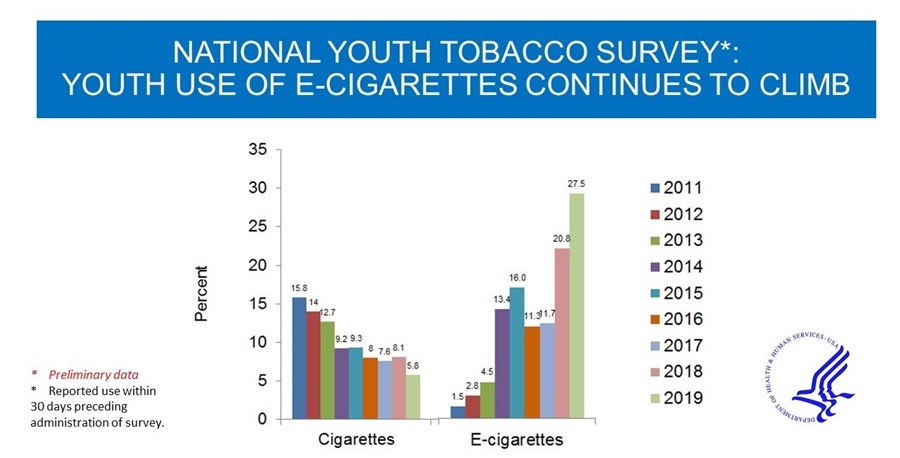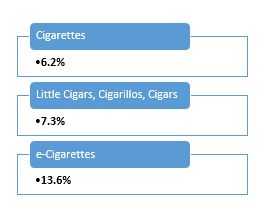What are e-cigarettes?

(Source: CDC, e-Cigarettes, 2019)
E-cigarettes have a battery-operated component that heats liquid containing nicotine, flavorings, and other chemicals. Heating the liquid (e-juices) causes formation of an aerosol which users inhale into their lungs. These electronic smoking devices come in different shapes and sizes and can look like regular cigarettes, pens, and even flash drives (similar to the popular brand “JUUL”). E-cigarettes go by many names including vapes, e-cigs, e-pens, e-hookahs and mods.
E-cigarettes are not a U.S. Food & Drug Administration (FDA)-approved smoking cessation aid. Not everyone is aware that there is nicotine in most e-cigarettes in varying amounts. Some pods of e-cigarettes contain as much nicotine as one pack of cigarettes (Truth Initiative, 2019). The sleek shapes and appealing flavors such as cotton candy, mango, and strawberry have made e-cigarettes especially enticing to youth.
Who uses e-cigarettes?
Nationally, e-cigarette use among high school students doubled from 11.7% in 2017 to 27.5% in 2019.

(Source: Department of Health and Human Services, 2019)
Youth use of e-cigarettes has surpassed youth use of regular combustible cigarettes in Delaware. According to the 2017 Delaware Youth Risk Behavior Survey (YRBS) of public high school students conducted by University of Delaware on behalf of the state Department of Health and Social Services (DHSS), 13.6 percent of students had used e-cigarettes in the past month while 6.2 percent smoked regular cigarettes. Approximately 38 percent of Delaware high school students reported ever trying an electronic vapor product.
Delaware High School Student Current Tobacco Use

2017 Delaware Behavioral Risk Factor Survey
According to the 2017 Behavior Risk Factor Survey (BRFS) conducted by DHSS, 4.8 percent of Delaware adults currently use e-cigarettes, roughly the same percentage reported in the 2016 survey. However, within the adult demographic, 12.7 percent of 18- to 24-year-old adults and 21.3 percent of males, ages 18-24, are “current users” of e-cigarettes.
Are e-cigarettes safer than regular cigarettes?
Although e-cigarettes do not contain all of the same chemicals as combustible cigarettes, there are still health risks associated with using them, especially for youth. According to the Centers for Disease Control and Prevention (CDC), e-cigarettes risks include the following:
- Nicotine is highly addictive, and can harm adolescent brain development, which continues into the early to mid-20s.
- E-cigarettes can contain other harmful substances besides nicotine including lead, nickel, tin, and cancer-causing chemicals.
- Many young people who use e-cigarettes also smoke cigarettes. There is some evidence that young people who use e-cigarettes may be more likely to smoke cigarettes in the future.
- Some of the ingredients in e-cigarette aerosol could also be harmful to the lungs in the long term. For example, some e-cigarette flavorings may be safe to eat, but not to inhale because the gut can process more substances than the lungs.
- Defective e-cigarette batteries have caused fires and explosions, some of which have resulted in serious injuries.
What can be done to prevent youth from using e-cigarettes?
There are several resources available to assist with learning more about e-cigarettes and educating youth about the risks. Resources are available for parents, educators, and health care providers.
RESOURCES
The CDC has a web page about e-cigarettes that provides general information as well as resources for parents, educators and health care providers:
CDC Quick Facts E-Cigarettes
The U.S. Surgeon General also has an e-cigarette web page with general information and resources for parents and health care providers:
Surgeon General E-Cigarette Info
Educators:
The CDC’s Office on Smoking and Health (OSH) developed this presentation to educate youth on e-cigarettes, including the health risks, the factors that lead to e-cigarette use, and what youth can do to avoid all tobacco products, including e-cigarettes. This resource is intended for adults who educate or serve youth ages 11-18 (teachers, youth ministers, coaches, scout leaders, etc.). Utilizing the talking points and information for the users’ document, the presenter does not require additional information, nor permission to deliver the presentation.
FDA Real Cost Campaign
“The Real Cost” campaign website and social media channels are intended for the campaign target audience only — youth ages 12-17.
Scholastic Real Cost of Vaping
The FDA collaborated with the Scholastic Corporation to develop lessons, activities and resources for teachers to increase awareness about the health consequences of youth e-cigarette use. The lessons and activities are made for grades 6-8 and 9-12.
Stanford Medicine Tobacco Prevention Toolkit
Theory-based and evidence-informed resources created by educators, parents, and researchers aimed at preventing middle and high school students’ use of tobacco and nicotine.
Evidence Brief: Tobacco Industry-Sponsored Youth Prevention Programs in Schools
The CDC presents this evidence briefly citing “Tobacco industry-sponsored school-based tobacco prevention programs are ineffective and may promote tobacco use among youth. Despite this, the tobacco industry, including e-cigarette product makers, has continued to engage in school-based youth tobacco prevention initiatives. Because the presence of the tobacco industry in school settings may increase the likelihood of youth tobacco product initiation, public health and school-based efforts to prevent youth tobacco product use are encouraged to remain independent of tobacco industry influences.”
CATCH
Coordinated Approach to Child Health (CATCH) collaborated with researchers at Michael & Susan Dell Center for Healthy Living at The University of Texas Health Science Center at Houston (UTHealth) School of Public Health to create CATCH My Breath™, a youth e-cigarette, vape, JUUL, and vape prevention program specific to grades 5-12.
Parents:
Surgeon General Tip Sheet for Parents
Nemours E-cigarettes for Parents
Health Care Providers:
Surgeon General Health Care Provider Conversation Card
Teens:
Nemours E-cigarettes for Teens
Cessation Resources for Youth:
American Lung Association Cessation Resources for Youth
![]() Please note: Some of the files available on this page are in Adobe PDF format which requires Adobe Acrobat Reader. A free copy of Adobe Acrobat Reader can be downloaded directly from Adobe . If you are using an assistive technology unable to read Adobe PDF, please either view the corresponding text only version (if available) or visit Adobe’s Accessibility Tools page.
Please note: Some of the files available on this page are in Adobe PDF format which requires Adobe Acrobat Reader. A free copy of Adobe Acrobat Reader can be downloaded directly from Adobe . If you are using an assistive technology unable to read Adobe PDF, please either view the corresponding text only version (if available) or visit Adobe’s Accessibility Tools page.






